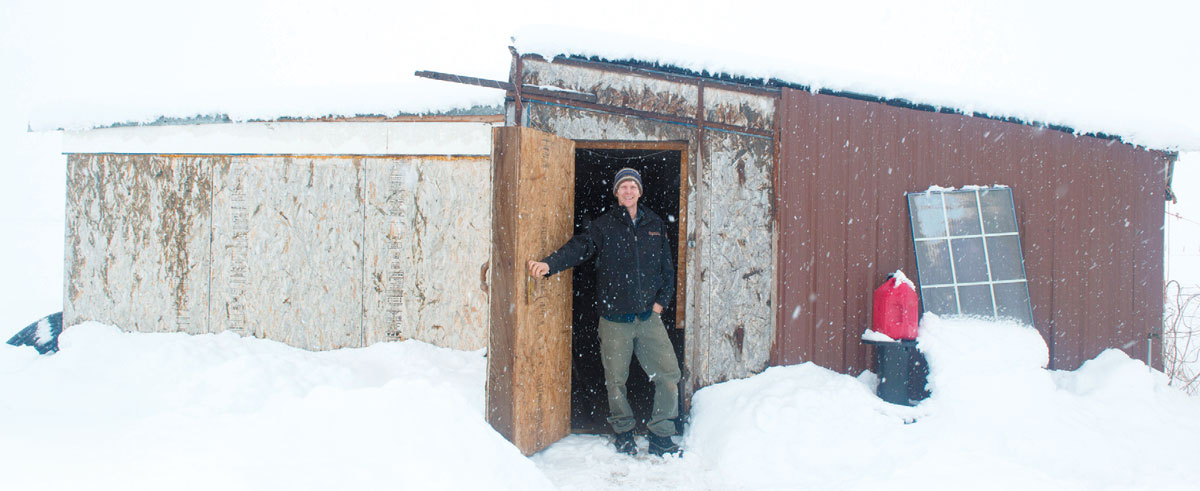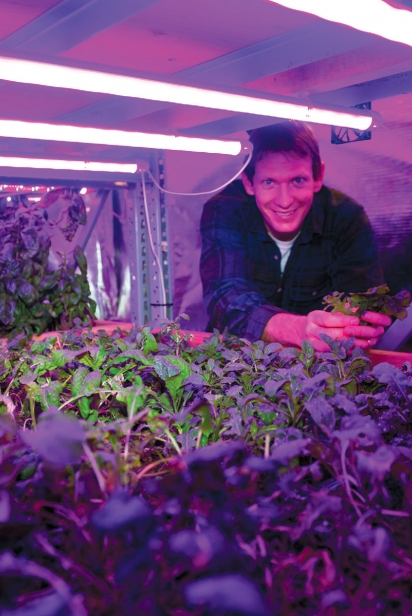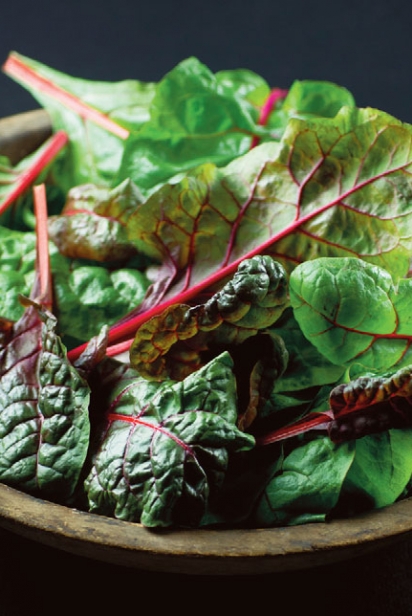Low Tech / High Tech
Fairfield farmers use LEDs to cultivate greens indoors
“Here, try this,” said Jamon Frostenson, holding out a piece of organic arugula freshly plucked from the soil. The little leaf hits my palate with an eye-popping warmth so sinus-clearing that it tasted more like horseradish than a salad green.
“It has a serious bite,” said Frostenson, co-owner of Fairfield-based Loganics produce company. The arugula variety is known as “Wasabi,” and it’s one of 40 organic greens and herbs Frostenson and Loganics co-owners Will Varin and Will Wardwell have been experimenting with in the LED-powered greenhouse.
Like the arugula, the greenhouse itself isn’t exactly typical. At first glance, it’s just another outbuilding: There are no windows and it is accessible only through a shed that also houses a chicken coop and a stalwart avocado sapling. But inside the greenhouse, it’s the culmination of five years of experimentation with what Varin calls “low-tech/high-tech” organic farming.
The greens and herbs are grown in beds of organic soil on large sliding racks that allow Frostenson to work between them. The floor is also dirt—but that’s where the similarities between this space and a more typical farming operation end. The building is heavily insulated with Structural Insulated Panels, or SIPs, which more often provide insulation for passive and LEED-certified homes. Approximately 60 sensors link to a computer on one side of the room that tracks air temperature, soil temperature, water content, humidity and light spectrum. The entire space is illuminated by high-efficiency LED lights that produce an eerie purple glow.
Despite all of this technology, Loganics has tradition at its heart. “We’re actually growing plants in dirt, not like hydroponics,” Varin said. “Fundamentally, the question we’re always asking is, ‘How do you make a plant happy?’”
But that question can get complicated, Frostenson said. He’s tested three greenhouse prototypes over the past five years, some with glass that couldn’t withstand the winter cold and an early version of his current iteration that couldn’t support enough produce to be cost-effective.
“We’ve had some utter failures and restarts and reconfigurations,” Frostenson added. “But we’ve learned.”
Learned, for example, that lettuces and herbs, rather than taller plants like tomatoes, were best suited to the greenhouse’s space-efficient design, and that those compact crops thrive in LED light. Frostenson was able to keep a crop of mustard greens growing for upwards of 200 days earlier this year. “If you have a 365-day growing period, the sky’s the limit,” he said.
Wardwell said the greenhouse makes organic farming easier by keeping out pests and objectionable weather that can damage plants— including a hailstorm that wreaked havoc on Fairfield grain crops last fall, but left the greenhouse untouched.
“It’s basically hermetically sealed,” Wardwell said. “It’s amazing how much you can regulate this environment.”
Manipulations of this environment can affect height, leaf-to-stem ratio, even overall plant size, resulting in myriad plant variations. The water required is minimal, an amount that could easily be collected through rainwater. And though the building isn’t heated, it’s so energy-efficient that residual heat from lights, plants and soil are enough to keep the interior temperature balmy.
These factors all allow Frostenson to grow unusual varieties of plants known for flavor or tenderness without subjecting them to harsh conditions, even in the depths of a Fairfield winter. Frostenson can adjust the greenhouse’s conditions so that the most flavorful varieties thrive and all of the greens and herbs taste like the essence of themselves.
One particular showstopper is a variety of kale that has the leaf size of standard kale but the tenderness of the baby version. It’s also the item that State & Lemp Chef Kris Komori said he’s probably purchased most from Frostenson; he serves it four ways in just one dish: as a chiffonade with pork and kale pot stickers, in a sauce made of kale purée and in a seaweed and radish salad.
“The flavor is very clean,” Komori said. “We use it for that nice, bitter note. It’s incredibly tender so we can serve it raw. People think it’s going to be overwhelming, but it blew us away.”
Komori intentionally keeps the flavors simple and clean when working with produce from Loganics.
“With a lot of Jamon’s things, we don’t do anything to them,” Komori said. “There’s nothing we can do to make them better.”
Soon, more chefs may have the opportunity to work with Loganics. Frostenson, Varin and Wardwell have plans to expand the operation to a larger greenhouse in Boise, where they can find a space big enough to produce the quantities needed to supply to more clients. But for now, Frostenson said he’s slowly supplying one or two items to additional Boise restaurants like Bittercreek Alehouse and The Modern Hotel and Bar.
“It’s easy to get something to work, but it’s hard to perfect it,” he added.
Loganics
300 E. 169, South Fairfield, ID 83327 • 208.764.2591







